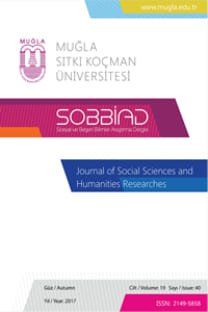E-LERANING READNESS OF FACULTY MEMBERS: A COMPARATIVE STUDY BETWEEN 20 AUGUST 1955- SKIKDA UNIVERSITY IN ALGERIA AND KILIS 7 ARALIK UNIVERSITY IN TURKEY
e-learning, Higher Institutions, Academik Staff
___
- Akaslan, D. and Law, E. L. (2010), “Measuring Teachers’ Readiness for e-Learning in Higher Education Institutions Associated with the Subject of Electricity in Turkey”, IEEE Global Engineering Education Conference, Amman, Jordan.
- Aydın, C.H. and Tasci, D. (2005), “Measuring Readiness for e-Learning: Reflections from an Emerging Country”, Educational Technology and Society. 8 : 244-257.
- Chanchary, F. H. and Islam, S. (2011), “Is Saudi Arabia ready for e-learning?- A case study”, The 12th International Arab Conference on Information Technology, Naif Arab University for Security Sciences, Saudi Arabia, retrivied : January 20, 2017, from : www.nauss.edu.sa/acit/PDFs/f2534.pdf.
- Chapnick, S. (2000), Are you ready for e-learning?, retrivied : January 20, 2017, from blog.uny.ac.id/nurhadi/files/.../are_you_ready_for_elearning.pdf.
- Contreras, J.O. and Hilles, S. M. S. (2015), “Assessment in E-Learning Environment Readiness of Teaching Staff”, Administrators, and Students of Faculty of Nursing-Benghazi University, International Journal of the Computer, the Internet and Management, 23(1) : 53-58.
- Haney, D. (2002), Assessing Organizational Readiness for e-Learning: 70 Questions to Ask. Performance Improvement, 41 (4) : 8-13.
- Kaur, K., and Abas, Z. W. (2004), “An Assessment of e-Learning Readiness at the Open University Malaysia”, International Conference on Computers in Education (ICCE). Melbourne, Australia.
- Mercado, C.A. (2008), “Readiness Assessment Tool for An eLearning Environment Implementation”, Fifth International Conference on eLearning for Knowledge-Based Society, December 11-12, 2008, Bangkok, Thailand.
- Oketch, H.A., Njihia, J.M. and Wausi, A.N. (2014),” E-learning readiness assessment model in Kenyas’ higher education institutions : A case study of University of Nairobi”, International Journal of Scientific Knowledge, 5(6) : 29-41.
- Ouma G. O., Awuor F. M., and Kyambo B. (2013), “E‐Learning Readiness in Public Secondary Schools in Kenya”, European Journal of Open, Distance and e‐Learning, 16(2) : 97-110.
- Pirani , J (2004), Supporting E-Learning in Higher Education. Educause Center for Applied Research, retrivied : January 20, 2017, from http://net.educause.edu/ir/library/pdf/ERS0303/ec m0303.pdf
- Ouma, G. O., Awuor, F. M. and Kyambo, B. (2013), “Evaluation of E-Learning Readiness in Secondary Schools in Kenya”, World Applied Programming, 3(10) : 493-503.
- Parlakkılıç, A. (2015), “E-Learning Readiness in Medicine: Turkish Family Medicine (FM) Physicians Case”, The Online Journal of Distance Education and e-Learning, 3(3) : 21-25.
- Qazaq, M. N. A. (2012), “A study on readiness and implementation of elearning among academic staff at Jordanian institutions of higher eduction”, Doctor of Philosophy thesis, Universiti Utara Malaysia.
- Ranjbarzadesh, F. S., Biglu, M. H., Hassanzadeh, S., Safaei, N. and Saleh, P. (2013), E-Readiness Assessment at Tabriz University of Medical Sciences, Res Dev Med Educ, 2(1) : 3-6.
- Rohayani, A. H. H., Kurniabudi ve Sharipuddin. (2015), A Literature Review: Readiness Factors to measuring e-Learning Readiness in Higher Education.International Conference on Computer Science and Computational Intelligence (ICCSCI 2015), Procedia Computer Science 59 : 230 – 234.
- Rosenberg, M. J. (2000), The e-learning Readiness Survey: 20 Key Strategic Questions You and Your Organization Must Answer About the Sustainability of Your E-Learning Efforts, retrivied : January 20, 2017, from books.mcgraw-hill.com/training/elearning/elearning_survey.pdf.
- Saekow, A. and Samson, D. (2011), “E-learning Readiness of Thailand’s Universities Comparing to the USA’s Cases”, International Journal of e-Education, e-Business, e-Management and e-Learning,1(2) : 126-131.
- Soydal, I., Gülten, A. and Yurdagül, Ü. (2012), “Are Turkish universities ready for e-learning: A case of Hacettepe University Faculty of Letters”, 16th International Conference on Electronic Publishing – ELPUB 2012 – Social Shaping of Digital Publishing: Exploring the Interplay between Culture and Technology.
- Vermeulen, L. (2011), Key Human Factors in the e-Readiness of Academic Employees at Higher Education Institutions, Doctor of literature and philosophy thesis, University of South Africa.
- ISSN: 2149-5858
- Yayın Aralığı: Yılda 2 Sayı
- Başlangıç: 2000
- Yayıncı: Mugla Sitki Kocman University
ANİ HARABELERİNİN BÖLGESEL KALKINMA ÜZERİNDEKİ ETKİLERİ
Hasret ÖZTÜRK, Muhittin TATAROĞLU
MOBİL PAZARLAMA UYGULAMALARININ Y KUŞAĞI AÇISINDAN DEĞERLENDİRİLMESİ: MUĞLA İLİ ÖRNEĞİ
ANTİK KARYA’NIN BAŞKENTİ HALİKARNASSOS’DA KENT PLANLAMA ANLAYIŞI
TRANSANDANT -AŞKIN- İDEALİZM DENEYİMİNDE BİR DÜŞÜNÜR- SANATÇI ÖRNEĞİ OLARAK VİNCENT VAN GOGH
